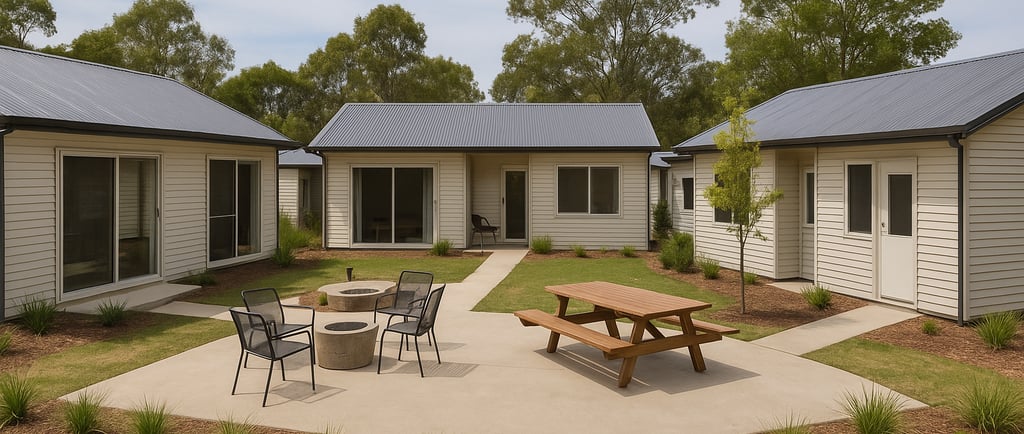The Value and Impact of Disability Cluster Unit Developments
Disability Cluster Unit Developments deliver inclusive, community-focused housing tailored to people with disability. This blog post examines how thoughtfully designed clusters enhance autonomy, support networks, and shared services. By balancing private spaces with communal areas, they foster independence, wellbeing, and social connection transforming housing from shelter into a foundation for thriving lives.
HOUSING
7/14/20253 min read


Introduction
Disability cluster unit developments, housing arrangements where multiple people with disability live independently in grouped dwellings, supported by an on-site carer and shared community space, are reshaping how societies accommodate and empower people with disability. These models offer a compromise between full institutional care and total independence, providing a supportive environment that encourages autonomy while ensuring safety and social connection.
This blog explores the core components, benefits, limitations, and optimal design features of such developments. It also examines real-world examples in Australia and internationally, while reflecting on the life-changing impact such options offer to ageing carers and parents who worry about their children’s long-term future.
Core Design Elements of Disability Cluster Units
1. Individual Units – Fully self-contained dwellings that offer privacy and dignity.
2. On-site Carer Unit – Staffed 24/7 or as needed, allowing rapid response to emergencies or support needs.
3. Shared Community Space – A communal area for socialising, shared activities, or meals, reducing isolation and fostering belonging.
These developments typically accommodate 4–10 participants, striking a balance between community feel and personalised care. Larger developments may risk institutional mimicry, while smaller ones may lack social viability or economic sustainability.
Pros of Cluster Unit Models
• Enhanced Independence: Residents live in their own space, making choices about daily life with minimal interference.¹
• Safety and Support: The proximity of carers offers peace of mind, with rapid assistance when needed.²
• Scalability of Care: A single carer can support multiple residents, optimising funding and service delivery.³
• Social Inclusion: Shared spaces create informal opportunities for connection, reducing loneliness — a known risk factor for mental health issues.⁴
• Future-Proofing for Families: Ageing parents often fear what will happen to their children when they are no longer able to care for them. These models provide a secure, known alternative.⁵
Challenges and Considerations
• Zoning and Infrastructure: Local planning schemes may resist cluster developments in suburban or semi-rural settings.⁶
• Staffing Consistency: Rotating carers can diminish trust or continuity of care.
• Group Dynamics: Matching housemates with compatible needs and personalities is crucial without it, conflict or disengagement may occur.⁷
• Design Risk: Poor design choices (e.g. lack of acoustic separation or shared access points) may reduce the perceived or real autonomy of residents.
Optimal Size and Configuration
Evidence suggests the optimal size is 4–6 units, each with one or two bedrooms, a private courtyard, and ensuite, located around:
- A central common room (for meals, recreation, visiting family).
- An adjacent staff base or carer’s unit with clear visual oversight but sufficient separation for privacy.
These configurations allow meaningful socialisation without overwhelming participants or replicating institutional features.
Australian Examples
1. The Summer Foundation’s Housing Projects – These are designed to blend in with mainstream housing while offering on-site support, typically co-located in small groups near transport, services, and parks.⁸
2. Project Independence (ACT) – A social housing model where people with intellectual disability co-own their home within a cluster, live independently, and access support from an on-site coach.⁹
3. Nightingale Evergreen (Melbourne) – While not disability-specific, this model has universal design principles and mixed-income residents, demonstrating cluster-type possibilities in urban renewal areas.¹⁰
International Examples
1. Camphill Communities (UK & Ireland) – These intentional communities involve shared homes, onsite carers, and communal facilities, often in rural or semi-rural environments.¹¹
2. Neatebox Smart Living (Scotland) – Pilots have combined tech-enabled housing with cluster support models for neurodivergent residents.¹²
3. L’Arche International – Offers small group homes integrated with local communities, where people with and without disabilities live and work together.¹³
Impact on Ageing Parents and Carers
The peace of mind that cluster housing brings to ageing carers is profound. It allows them to:
- Transition care responsibilities gradually.
- Participate in planning and visits while they are still active.
- Reduce anxiety over their child’s future after their death or incapacitation.¹⁴
Many families note that knowing their adult child is settled, safe, and part of a supportive community dramatically reduces their stress, enhances their own wellbeing, and enables better long-term care planning, including estate and guardianship arrangements.
Conclusion
Disability cluster unit developments are not a silver bullet but represent a powerful solution for many individuals and families seeking independence, safety, and community. When done well with thoughtful design, skilled staffing, and responsive governance they can change lives. For governments, developers, and not-for-profits, these models offer a replicable, human-scale approach to bridging the gap between disability housing needs and lived inclusion.
Footnotes
1. Bigby, C., & Wiesel, I. (2020). Enabling inclusion in housing design. Melbourne Disability Institute.
2. National Disability Insurance Scheme (NDIS). (2023). SIL and SDA Practice Guidelines.
3. Productivity Commission. (2017). NDIS Costs Report.
4. Australian Institute of Health and Welfare. (2021). Social isolation and mental health.
5. Carers Australia. (2022). Aging Parent Carers in Australia.
6. Urban Development Institute of Australia. (2020). Planning Barriers to Inclusive Housing.
7. Clement, T., & Bigby, C. (2009). Journal of Applied Research in Intellectual Disabilities.
8. Summer Foundation. (2023). Housing Hub Projects. https://www.summerfoundation.org.au
9. Project Independence. (2024). Supported Home Ownership. https://projectindependence.com.au
10. Nightingale Housing. (2023). Evergreen Project Overview. https://nightingalehousing.org
11. Camphill Communities. (2023). About Us. https://www.camphill.org.uk
12. Neatebox. (2023). Inclusive Smart Living Projects. https://www.neatebox.com
13. L’Arche International. (2023). Community Living with Dignity. https://www.larche.org
14. Council on the Ageing (COTA). (2022). Planning for the Future When You Are a Carer.


Far North Consulting Pty Ltd t/a Groundwork Consulting
© 2025 Groundwork Consulting
ABN 77 649 525 806
MAKING GOOD IDEAS WORK
Video Platform Links





